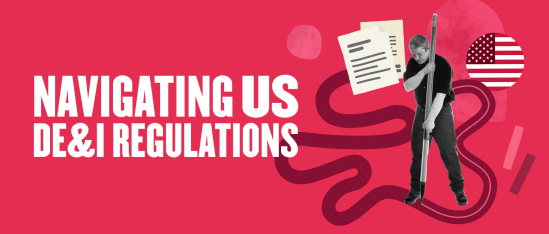There are many hurdles to overcome in the effort to implement true diversity, equality, and inclusion within an organization. The work is necessary, rewarding, and worthwhile—but challenging nevertheless.
For businesses operating in the United States, DE&I laws that introduce an entirely new set of considerations and constrictions in addition to the ones your company has in place only amplify the challenges.
Not only are there federal anti-discrimination laws to consider, but individual states and even counties have their own rules and variations to contend with, as well. To ensure compliance across the board, consider aligning your company’s DE&I policies with the DE&I employment laws in California, New York, Illinois, Oregon, or Washington. These states have the strictest regulations, so if your organization meets them, it should meet the compliance standards almost anywhere in the US.
It can get tricky for larger companies
The complexity of complying with laws about diversity and inclusion magnifies significantly if your business has branches across multiple states. You’ll have to figure out how to balance stricter pro-diversity laws like California’s with anti-DE&I laws like Florida’s “anti-woke” Individual Freedom Act. After all, people have sued companies in the past, claiming that DE&I efforts were themselves discriminatory. Consulting with a lawyer is vital if you operate in states with wildly different approaches to diversity laws in the workplace.
It’s more than the law: DE&I boosts the bottom line
Nobody wants to face fines for failing to comply with laws on diversity and inclusion. But that’s far from the only reason your business should commit to promoting diversity in the workplace. Studies reveal one resounding fact: DE&I is great for the bottom line.
McKinsey’s 2019 analysis revealed that companies in the top quartile for gender diversity on executive teams were 25 percent more likely to have above-average profitability than companies in the bottom quartile. This number increases from year to year.
Research also shows that DE&I policies correlate to a 42 percent increase in workforce productivity. This is in addition to 33 percent more happiness, 32 percent more creativity and innovation, and 31 percent more ease in attracting new talent.
This is especially the case with the newest generation of professionals, with 83 percent of Gen Z individuals stating that they find an employer’s commitment to diversity and inclusion to be significant when choosing where to work.
To help you navigate the choppy waters of DE&I policies, anti-discrimination laws, state-to-state variations, and anti-DE&I pushback, here are some important things to keep in mind.
You can do it all
One important thing to keep in mind is that, when it comes to DE&I efforts, compliance should be just one of many considerations. An effort to understand and follow the laws is no more important than a genuine desire to incorporate the principles of diversity, equity, inclusion, and belonging into your company culture.
Here are some tips to help you balance both of these elements, as much as they may seem to contradict at times.
- Recruit a great legal team. You don’t have to figure out the puzzle of state, federal, and local DE&I laws on your own. Hiring a legal team that specializes in DE&I and anti-discrimination will help you stay up to date on the newest legislation, ensure your compliance, and bulletproof your policies and procedures.
- Invest in training. It’s essential to train all team members, managers, and executives on equal opportunity laws to prevent discrimination against job candidates and employees who are part of a protected class. In addition to clarifying your anti-discrimination policies, it’s good practice to ensure all your people know how to file a complaint in case of an incident.
- Walk the walk. If and when discrimination complaints come in, it’s critical to take action. If a team member can prove that you knew of a discrimination issue and did nothing about it, they will have grounds to file a lawsuit.
- Include everyone. Transparency and involvement in the creation of DE&I policies and initiatives are key. Invite people from all backgrounds to have a seat at the table, allowing them to voice their opinions. This includes people from majority groups, who may also perceive that they have limited opportunities due to DE&I policies created to promote diversity.
- Tread lightly. As far as the EEOC is concerned, it is just as possible to discriminate against a person based on their majority status as it is their minority status. For this reason, it’s important to be careful and not unintentionally discriminate against somebody in an effort to hire more people of color or pay women fairer salaries, for example.
- Be proactive. True DEI&B doesn’t only respond to problems as they arise, and it’s not satisfied by doing the bare minimum required to comply with legal requirements for diversity in the workplace. It’s just as important to actively identify policies you may currently have in place that could be unintentionally replicating existing structural inequalities, expand outreach to underrepresented populations, and uplift minority groups with training and promotion—among other things.
Recommended For Further Reading
How do laws support a culture of diversity and inclusion?
Compliance doesn’t have to be a thorn in your side. With the right support and mindset, you should be able to integrate your efforts to comply with diversity and inclusion laws with your desire to create a more genuinely diverse and inclusive workplace that is equitable to all. As long as you aim to be fair to everybody—minority and majority groups alike— all members of your organization should feel that the policies support and protect them.


